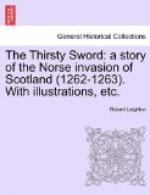During the minority of Alexander the Third all efforts to reduce the isles were abandoned. But now that the king was no longer a boy, he was resolved to compel all these vassals of Norway to renounce their allegiance and acknowledge their adherence to the Scottish crown.
On the appointed day Sir Piers de Currie crossed over to Bute. He was a man of middle age, tall and strong. His gigantic limbs were hard and stout as the trunk of an oak sapling. He wielded the longest sword and the heaviest battle-axe in Bute and Arran, and he was the best bowman in all the lands of the Clyde. His life among the mountains of Arran had given him a mighty power of endurance, for it was his habit to rove for many days over the craggy heights of Goatfell, climbing where none else could climb, slaying deer, spearing salmon, following the wild wolf to his lair, sleeping on the bare heather, drinking naught save the crystal water of the mountain burns, and eating the simplest food. His band of retainers, though scarcely less strong of limb than their master, were wont to say that their labours were even as those of the mythical Sigmund, who was condemned to make a new island in the ocean of the rocks that he clove from the topmost peaks of the Mountain of the Winds.
And yet they loved their master by reason of his strength and power, for he was the king’s nephew in Arran, and would some day be the lord of that isle and of the great castle of Brodick.
Landing on the shores of St. Ninian’s Bay, he strode with great strides towards Rothesay, and Lulach the herd boy, seeing him, thought him the most gallant warrior in all the world, and wondered what his business might be in Bute, and why he should have come over without a train of attendants.
It took the knight but a little time to cover the four miles between St. Ninian’s and Rothesay, and on the sloping strand of the bay he found Earl Kenric busy with his retainers carrying stores down to a great galley that was moored against a stone pier in the little creek near to the castle gates.
This ship, which was built in the shipyard of Rothesay, was entirely of oak and of great dimensions, ornamented with richly-carved dragons overlaid with beaten gold. It had ten banks of oars, each of the twenty long oars being rowed by two sturdy islanders. There was also a stout mast, upon which, when the wind served, a wide-spreading square sail might be hoisted.
“A gallant bark, by my faith! a gallant bark, Kenric!” said Sir Piers as he stepped on board and walked towards the high poop. “Would that we had a dozen such vessels, and manned by as brave a set of islanders as you have here. Then might we hope to make a bold stand against any sea rover out of Norway.”
“Five other galleys the like of this are now lying at safe anchor in the bay of Kames,” said Kenric; “and had we yet another half dozen, there are men-at-arms in plenty to man them — all trained in the use of sword and longbow, and eager enough, I warrant, to have a fling at Hakon’s valiant vikings.”




